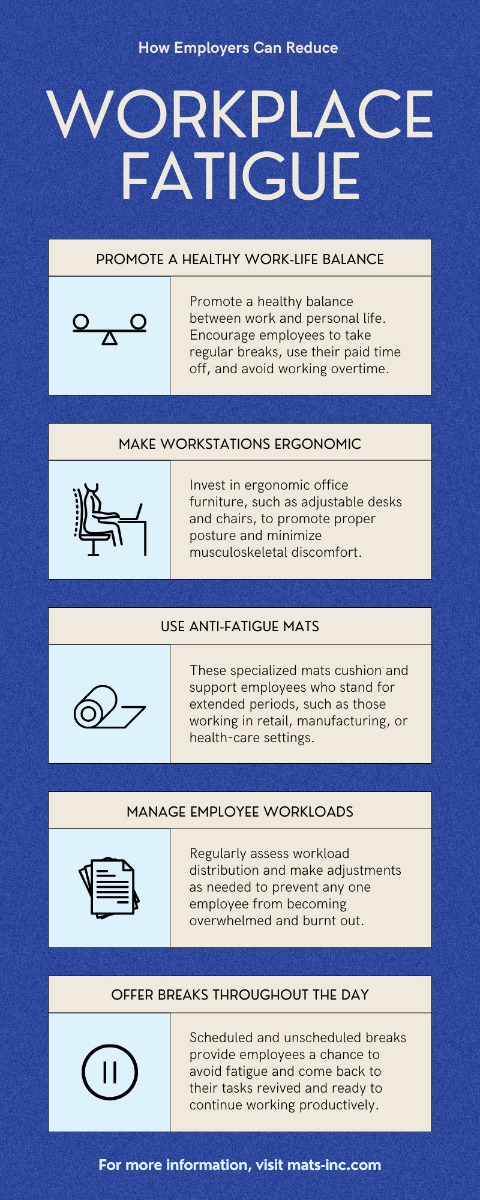How Employers Can Reduce Workplace Fatigue

Employee fatigue poses numerous risks to businesses of all kinds. Whether mental or physical in nature, fatigue can decrease productivity while increasing errors and safety risks. In today’s demanding, fast-paced work environments, many employers struggle to combat workplace fatigue among their employees. Fortunately, combatting workplace fatigue is possible. With strategic, proactive approaches to combatting fatigue and the right tools, employers can effectively reduce workplace fatigue to create a more energized, alert, and productive workforce. Keep reading to learn how employers can reduce workplace fatigue.
Promote a Healthy Work-Life Balance
One of the main reasons for workplace fatigue is when work and personal life are out of balance. When employees overwork themselves, they’re more likely to feel exhausted and burnt out. Working outside of regular hours can also disrupt sleep and rest time.
Employers can reduce employee fatigue by promoting a healthy balance between work and personal life. They can do this by encouraging employees to take regular breaks, use their paid time off, and avoid working overtime. Offering flexible work arrangements, like working from home or flexible hours, can also give employees more control over their schedules, which can reduce stress and fatigue.
Make Workstations Ergonomic
Workplaces should focus on ergonomic workstation designs and tools to combat fatigue. Ergonomics focuses on designing workspaces and equipment to fit the capabilities and limitations of the human body, reducing strain and fatigue. Employers can invest in ergonomic office furniture, such as adjustable desks and chairs, to promote proper posture and minimize musculoskeletal discomfort.
Additionally, providing employees with ergonomic tools like keyboards and mice can prevent repetitive strain injuries and improve overall comfort. If employees work remotely, employers can consider offering a home office stipend to help employees furnish their workspace with ergonomic furniture and equipment.
Use Anti-Fatigue Mats
Like ergonomic furniture, anti-fatigue mats can reduce strain on employees’ muscles throughout the day, reducing fatigue at and outside of work. These specialized mats cushion and support employees who stand for extended periods, such as those working in retail, manufacturing, or health-care settings. By reducing the strain on the feet, legs, and lower back, anti-fatigue mats can improve comfort and energy levels and increase productivity. Additionally, this supports and decreases muscle strain and reduces fatigue-related injuries, saving employers time, money, and headaches. If you want to purchase anti-fatigue floor mats for your business, check out Mats Inc. No matter your industry, our floor mats will help you reduce employee fatigue in your workplace.
Encourage Physical Activity Outside of Work Hours
Regular physical activity is crucial in combating fatigue and boosting energy levels. Although employers can’t make their employees stay physically active, they can take steps to encourage employees to prioritize staying active outside of work. Employers can encourage employees to prioritize physical activity by offering wellness programs, gym memberships, or onsite fitness facilities. Encouraging employees to take short walks or stretching breaks throughout the workday can also combat the sedentary nature of office jobs and promote circulation and energy levels.
Foster a Positive Work Environment
Having a positive work environment can significantly impact employee morale and energy levels. Employees who feel negatively about their job or work environment are more likely to feel run down and burnt out at the end of each workday. Employers should strive to create a culture of appreciation, recognition, and open communication. Recognizing and rewarding employees for their hard work and achievements can boost morale and motivation, reducing feelings of burnout and fatigue.
Additionally, fostering strong relationships among team members and promoting a collaborative and supportive atmosphere can contribute to a more positive and energized workplace. Employers should create an environment where employees can voice their feedback or concerns so that they can continually improve the environment for the individuals who work there.
Manage Employee Workloads
Excessive or constantly fluctuating workloads can quickly lead to burnout and fatigue among employees. Employers should regularly assess workload distribution and make adjustments as needed to prevent any one employee from becoming overwhelmed and burnt out. This may involve reallocating tasks, streamlining processes, or hiring new employees as needed.
Employers should take proactive measures to make adjustments before work becomes overwhelming, such as hiring in anticipation of increased work instead of waiting until employees feel like they’re drowning in tasks. Open communication channels between supervisors and employees can help employers identify and address these workload issues before they escalate. Employers should also remember the importance of a positive work environment when making these decisions and prioritize supporting employees to avoid fatigue.
Offer Breaks Throughout the Day
Whether the employer is a manufacturing company, retail shop, or large financial corporation, all employers should ensure their employees receive time to rest throughout the workday. Though it may be tempting to encourage employees to work as hard as they can all the time, this approach is ultimately less productive than encouraging employees to take breaks throughout the day. Scheduled and unscheduled breaks provide employees a chance to avoid fatigue and come back to their tasks revived and ready to continue working productively. Otherwise, employers risk having distracted, riskier employees who are more likely to make mistakes due to their fatigue.
Conduct Regular Workplace Assessments
Employers can take several steps to reduce employee fatigue and improve their work environment. Along with seeking feedback from employees, they can conduct workplace assessments to identify areas for improvement. Such assessments may include ergonomic evaluations, workload surveys, and fatigue risk assessments. Engaging employees in the assessment process can help employers identify areas for improvement that are most important to their staff.
The Bottom Line
Though workplace fatigue is a major problem for employees and employers, it isn’t unavoidable. Now that you know how employers can reduce workplace fatigue, you can create a workplace environment that supports your employees and prevents the hazards associated with fatigue. As you combat fatigue, you’ll keep employees safer, healthier, and happier to continue working for your company. Ultimately, combatting fatigue helps your business stay safe and productive and encourages employee retention by creating an organization that employees want to continue working for.



